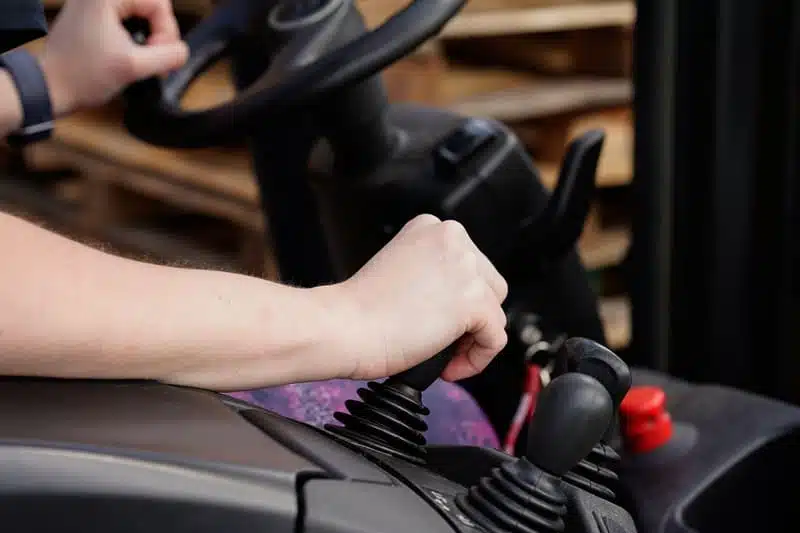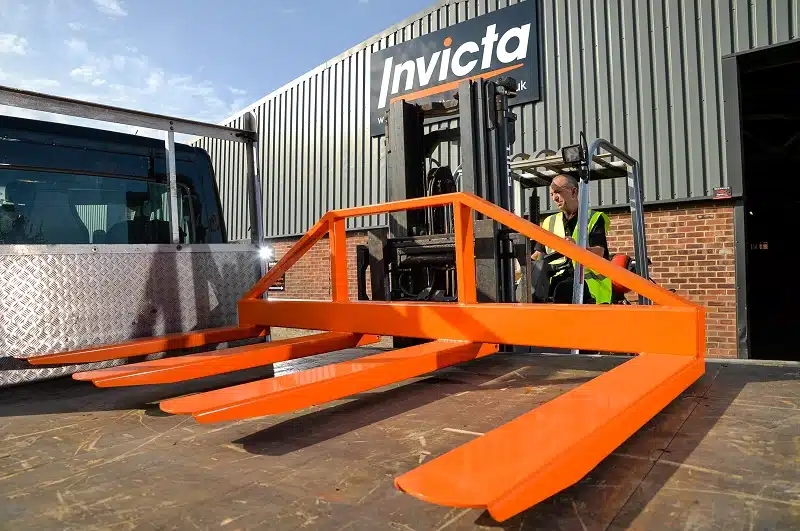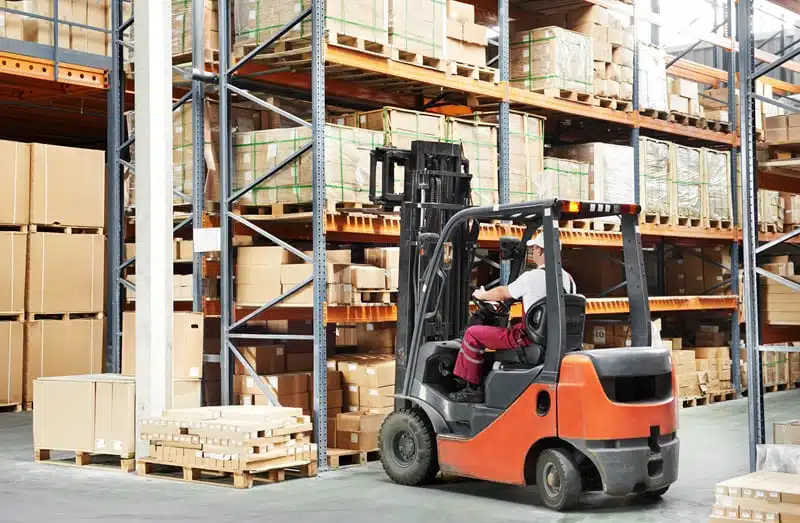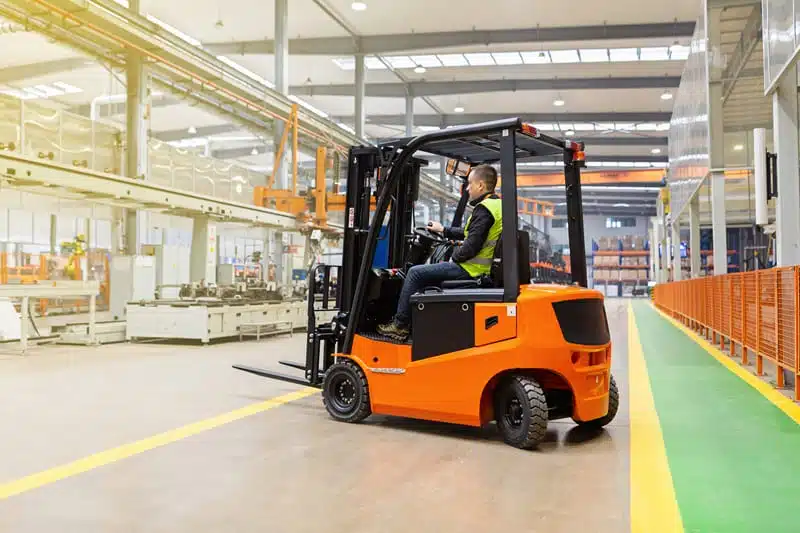Forklift safety: reasons why trucks topple over

Forklift tip-overs put people at risk, damage equipment and cost valuable time. Most can be prevented with the right knowledge and the right attachments. Knowing the reasons why forklifts topple over and how attachments affect their safe working capacity helps you stay in control.
At Invicta, we design and manufacture attachments that let you handle awkward loads safely and within your limits. Here’s how to reduce the risk of tipping and keep every job steady from start to finish.
The quick answer: top reasons why forklifts topple over
Most tipping incidents come down to a handful of avoidable causes:
- Overloading: exceeding the truck’s rated capacity
- High loads and raised masts: lifting the centre of gravity outside the stable zone
- Turning too fast: especially with a load or on uneven ground
- Uneven surfaces and gradients: slopes, ramps and rough yard surfaces shift the centre of gravity
- Poor load positioning: off-centre or unbalanced loads create instability
- Wind and exposure: tall or wide loads can catch the wind outdoors
- Unsuitable attachments: using the wrong attachment for the task at hand
- Worn tyres: reducing overall grip and stability
- Inadequate training: operators not up to date with safe handling practices
- Poor visibility and housekeeping: obstructions, debris or unclear sightlines

Forklift stability explained: the stability triangle, load centre and rated capacity
Think of a counterbalance forklift truck like a seesaw – it balances a heavy counterweight at the back with a load in the front. Like a seesaw, the forklift will tip forward if the weight of the load overpowers the counterweight. That means the combined centre of gravity of the forklift and its load need to stay balanced to prevent tipping.
The stability triangle
Counterbalance trucks rely on a concept called the stability triangle, which connects three points: the two front wheels and the centre of the rear axle. As long as the centre of gravity stays inside that triangle, the forklift will stay stable. If an operator moves the centre of gravity by lifting too high, carrying an off-centre load or turning too sharply, the truck tips over.
The load centre
The load centre is the halfway point from the face of the forks to the centre of the load you’re carrying. It directly affects how much weight the truck can safely lift. How far away the load centre is from the forklift affects how much weight the truck can safely lift.
Rated capacity
Your truck’s rated capacity is specified by the manufacturer and lets you know the maximum weight the forklift can safely lift. It’s found on the capacity plate and assumes that the truck is on even ground with no attachments fitted. If any of these conditions change, the safe working capacity changes too.
How attachments change your truck’s capacity: deration and compliance
An important point to remember is that attachments do not increase your forklift’s capacity. They allow you to handle different types of loads safely, but they reduce the truck’s rated capacity in the process.
This is called deration, and it happens for two reasons:
- Added weight: the attachment itself adds weight to the front of the truck, reducing how much you can safely carry
- Load centre shift: many attachments move the load further from the mast, which reduces capacity even more
When you fit an attachment, the original rated capacity is no longer valid. The capacity data plate must be updated to reflect the new, reduced lifting capacity. This is a legal requirement under the Lifting Operations and Lifting Equipment Regulations (LOLER) and the Provision and Use of Work Equipment Regulations (PUWER).
You can contact your attachment manufacturer, an authorised dealer or a competent engineer for an updated capacity plate.

Choosing the right attachment for the job
The right attachment makes awkward loads safer to handle, as long as you stay within the derated capacity. Some of the most common types include:
Fork extensions extend the reach of the forks. They’re used to handle long or awkward loads that extend beyond the length of standard forks.
Jibs convert a forklift into a mobile crane, allowing it to lift loads that are difficult to handle with forks alone. They’re ideal for lifting and positioning unpalletised loads that can be hung from a hook.
Also known as access platforms or safety cages, these attachments safely lift employees to work at height in cases where ladders or scaffolding aren’t practical.
Load backrests create a barrier that prevents loads from sliding back toward the operator. They’re used for large or unstable loads and are an essential safety feature for many forklifts.
Scoops and buckets turn a standard forklift into a versatile loading shovel. They’re designed to effectively handle loose materials like sand, gravel, soil and waste.
Not sure which attachment fits your needs? Get in touch with our team for expert guidance on the right fit for your site.
Safe handling of awkward loads without exceeding rated capacity
Awkward, oversized or off-centre loads account for a lot of tip-over incidents. The right attachment helps you handle them safely, but you still need to work within the truck’s limits.
Long or oversized loads
Long or oversized loads can create a change in the load centre, making the truck prone to tipping. Fork extensions give you the reach to support the full length of the load. Always check the derated capacity, keep the load low and avoid sharp turns.
Off-centre loads
Even with the correct attachment, an uneven load can move the centre of gravity outside the stability triangle. Position the load as centrally as possible, travel slowly and avoid sudden turns.
Elevated work
Access platforms keep operators stable at height, but only if the truck stays on firm, level ground. Avoid working on slopes and never move the truck with the platform raised and occupied.
Uneven yards and rough ground
Debris, potholes and sloped surfaces all reduce stability. Keep loads low, reduce speed and use attachments designed for the surface you’re working on. If the forklift is not designed for tough terrain, switch to an alternative vehicle.

Operator best practice to prevent tip-overs
Most tip-overs happen in familiar situations, like a turn taken too fast, a mast raised higher than usual or a gradual slope that doesn’t appear too steep. It’s often a combination of small factors that stack up until the truck’s centre of gravity shifts outside the stability triangle.
Here’s what operators should do – and avoid:
Do:
- Slow down on turns, gradients and uneven ground
- Keep loads low during travel and tilt the mast back
- Complete pre-use checks on the mast, forks, attachments, locking pins and hydraulics
- Inspect tyres regularly for wear or damage that could reduce grip
- Keep your work area clear with good visibility and sightlines
- Make sure your training covers attachment use, capacity limits and site-specific risks
Don’t:
- Take corners or turn quickly, especially with a raised mast or on uneven ground
- Travel with the mast raised higher than necessary
- Accelerate or brake sharply, especially on slopes or wet ground
- Ignore debris, potholes or changes in ground conditions caused by weather
- Use attachments without checking the derated capacity and updated capacity plate
- Operate equipment with worn tyres or damaged components
- Assume experience alone is enough – refresh your knowledge when using new attachments or working in different environments
FAQs
Do attachments increase forklift capacity?
No, forklift attachments do not increase forklift capacity. They actually reduce your truck’s rated capacity due to their weight and the shift in the load centre. You will need updated capacity data and a new capacity plate before use.
How do I calculate new capacity with an attachment?
The attachment manufacturer or a trained engineer can provide derated capacity data based on the attachment’s weight and dimensions. This data must be displayed on the truck and is a legal requirement under LOLER and PUWER.
What’s the safe way to use fork extensions?
Extensions alter a forklift’s load-handling abilities by shifting the load centre and reducing stability. Always ensure the extension is the correct size to fit over the existing fork, and that the length doesn’t exceed 1.5 times the length of the original fork. Fork extensions must be correctly fitted and secured using a heel pin.
When must I update the capacity plate?
You need to update the capacity plate every time you fit an attachment that changes the truck’s capacity or load centre. It’s a legal requirement under LOLER and PUWER.
Are attachments covered by LOLER/PUWER?
Yes. Attachments are lifting accessories and need to be inspected as part of your regular Thorough Examinations – typically every six months.
Speak to Invicta
If you’re not sure which attachment suits your load or site, our team can help. We manufacture forklift attachments here in the UK, keep stock ready to go and can design bespoke attachments for tricky loads or tight yards. Every attachment we supply comes with the capacity data and compliance documentation you need to stay safe and legal.
Talk to our team for capacity guidance, get a quote on in-stock attachments or arrange a bespoke build tailored to your site. With decades of experience and fast UK delivery, we’ll help you handle loads safely.
Back to all blog posts

